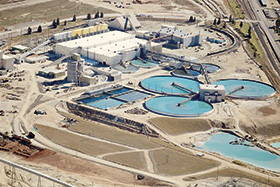The complexity of water management in mines
Published on by Water Network Research, Official research team of The Water Network in Case Studies
Water is a critical resource for the mining industry, either in the mining processes, as a feed to the beneficiation of minerals process, or for potable use. With the growing demand and increased scarcity of usable water, it is very important for mines to prove that they utilise water optimally, by suitable reuse and reclamation of contaminated water.
Water demand management and conservation forms an important part of mining operations, irrespective of whether it uses surface or ground water and whether it impacts downstream water resources. By implementing state-of-the-art water management systems, mining companies will start to realise the importance of the water they use and will therefore recognise the scarce resource as an invaluable asset in their operations.
The key steps in the implementation of water conservation and water demand management (WC/WDM) are based on resource protection and waste management, and entail the following:
• Prevent pollution and avoid water use by implementing waterless processes.
• Reduce water use through optimised technology.
• Reuse and recycle water as far as possible in accordance with applicable regulations.
• Disposal of water or treated wastewater that is not reused, in a responsible manner so as not to pollute the receiving environment.
• Always strive for greater efficiency in the use of water through the process of continual improvement using feedback and adaptive management.
Water reuse and reclamation
Endress+Hauser has been a valuable partner in the global water and wastewater industry for more than 65 years and in Africa for 35 years. Based on that industry expertise, the following are some examples of where the company’s products, solutions and services can be utilised in the implementation of the DHWS Best Practise Guidelines (BPG) for water management in the mining industry.
BPG H3: Water reuse and reclamation: the reuse and reclamation of contaminated water is important for any mining operation as it indicates that they optimise their water utilisation. All new and existing mines are required to prove this optimisation of water reuse and reclamation by having a Water Reuse and Reclamation plan.
This plan must consider the water and salt balance over the lifetime of the mine. Accurate measurement and storage of water abstraction, use and release data will assist in maintaining a historical record of long-term water balance. The Endress+Hauser Proline Promag family of electromagnetic flow meters can be utilised for accurate measurement of all water sources on the mine, whether potable water, raw water or water contaminated with chemicals. The embedded Heartbeat Technology in the meters ensures that users are at all times aware of the health of their flow meters and the reliability of the data they provide.
Although the Endress+Hauser Proline range of flow meters are calibrated using a certified calibration rig, the mine will be required to prove the accuracy of their water balance by doing traceable verifications every 6-12 months. With the Heartbeat Technology embedded in each Proline flow meter, the verification certificates can be obtained using a laptop (no additional tools or modems) or even remotely over an industrial fieldbus network, where available.
Water monitoring systems
One of the ways Endress+Hauser can support a mine in their monitoring programme is by implementing standard or customised smart water monitoring systems. This includes an easy-to-implement solution consisting of the Liquiline water quality measurement system, an edge device connecting to the Endress+Hauser Netilion services and a customised app or dashboard, to monitor measurement points remotely. With an application programming interface (API), the data can be made available in the relevant data management systems.
By utilising Heartbeat Technology in the Liquiline liquid analysis systems, the mine can be assured to receive early warning of faulty devices or parameters, so it can be addressed timeously, ensuring accurate and reliable data always.
To ensure reliable water usage and quality monitoring, including leakages and pollution events, accurate and reliable measurements are required. Heartbeat Technology in measurement devices organises clear, standardised diagnostic messages of what needs to be done to maintain the plant economically, based on necessities. Along with this it enables predictive maintenance and delivers evidence for operational reliability and process safety. As the devices run their own diagnostics, proof tests are only necessary in maximum extended cycles.
By connecting all the process measurement instrumentation to the Endress+Hauser Netilion hub, using any of the available industrial communication protocols, the customer will have access to all the process variables, health information, as well as any maintenance, events and product documentation.
Taxonomy
- Instrumentation
- Process Control
- Control Systems
- Monitoring & Control
